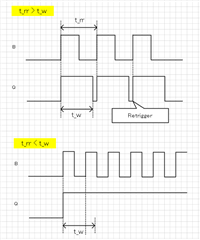Tool/software:
Hi,
I have any questions.
I have a question about the minimum input retriggering time.
Looking at the input and output relationship in Figure 7, I understand that if t_rr of /A is shorter than t_w, output Q will remain High, and if t_rr is longer than t_w, output Q will alternate between High and Low.
I am considering this in conjunction with the Rext/Cext waveforms.
However, it says that t_mir=t_w*0.3 is the minimum input retrigger time, but where does this fall in relation to Figure 7?
Best Regards,
Ninomiya


